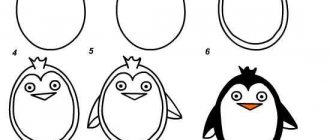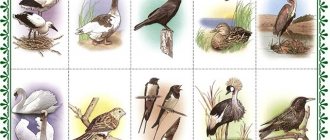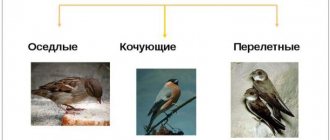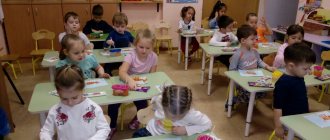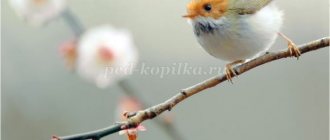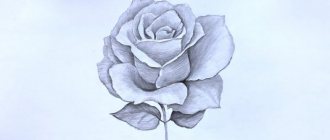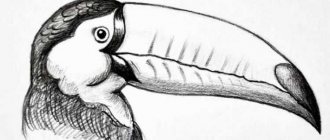Summary of Direct Educational Drawing Activities for children 3-4 years old “Grains for Birds”
Purpose:
To develop the artistic and creative activity of children.
Objectives:
Educational objectives Expand the visual capabilities of children, develop the ability to draw in an unconventional way - with cotton swabs;
give children knowledge about the life of birds in winter; consolidate knowledge of color (yellow), shape (round), size (small), quantity (“one”, “many”). Enrich children's vocabulary with new words. Developmental Develop fine motor skills of the hand; develop the ability to draw with complexity (in a limited space). To develop children’s play activity, the ability to act together in the outdoor game “Birds”. Develop motor activity and coordination of movement during the physical exercise “Birds. Educational To cultivate a humane attitude towards birds, to evoke a desire to help them. Vocabulary:
feeder, sparrow, grains.
Equipment
Handouts: Sheets of paper with a picture of a feeding trough for each child; yellow gouache, cotton swabs for each child. Millet, disposable plates for each child Demonstration material: feeder, birds cut out of paper, drawn tree. Preliminary work Bird watching during walks; examination of didactic material, illustrations in books; listening to audio recordings of bird calls.
Progress of direct educational activities
Guys, let's say hello to our guests. Let's smile at the guests, smile at each other. How nice and joyful it is to start a new day with a smile! Children sit on chairs. At this time there is a knock on the door. The teacher brings in the feeder. - Guys, what do you think this is? (children's answers) - That's right, this is a feeder. Let's repeat in unison: feeder. -Who is this feeder for? Why do birds need a feeder? What do birds eat? (children's answers) - Let's look at the grains that I prepared for the birds. Children approach the table, on which there are plates with millet for each child. -What color are the grains? What size? What shape? At this time there is a knock on the window. Children come to the window and see a sparrow cut out of paper attached. -Oh, guys, who is this? (children's answers). This is a little sparrow. I think that he flew to us not by chance. Why do you think he came to us? (children's answers). -That's right, the little sparrow is cold and wants to eat. Shall we feed him? -What will we feed the sparrow? Where should we put the grains? Take the grains with your fingers, like this, and pour them into the feeder. Children pour grains into the feeder, and the sparrow “pecks” them. -Sparrow, he ate his fill and sang his song. How does the little sparrow sing? -Guys, do you want to turn into sparrows? (answer) Physical exercise
Sparrows sit on branches and look at the street (children squat, turn their heads to the right, left). They want to take a walk and fly quietly.
(stand up, wave their arms) They flew, flew and sat on the branches. An audio recording of a sparrow chirping sounds. -It seems to me that the sparrow was not alone in our group. Let's see who sings so loudly. Children approach a tree on which sparrows “sit”. -Guys, who is this? How many of them arrived? What do they want? Oh, guys, we don’t have any grains left to feed the birds, but we have paints and we can get grains…. What to do? Draw it correctly. Sit down at the tables, each of you has a feeder in which you will draw grains. I also have a feeder, watch how I draw the grains. What color are the grains? What shape are they? What size? That's right, I'll take a cotton swab, dip it in water, then dip it in yellow paint and lightly poke the grains. How round do my grains turn out? Birds eat in the feeder, so you need to try to prevent the grains from “waking up” past. Now draw the grains yourself, each in your own feeder. While working, you need to monitor your posture and how the child holds the stick. As the work progresses, ask the child what he drew, what color, what shape. Well done, you did a good job and a little sparrow flew into your feeder. Remove the bird from the tree and place it in the child's feeder. Do as work progresses. “You guys are great, you tried really hard.” Your fingers tried hard, they are tired and want to rest. Finger game.
- Sparrow, sparrow, where have you been?
(they shake their finger) - I washed my paws on the river (wash my hands) - The wind blew, I fell (they blow on their palms and hide their hands) - I got my paws dirty in a puddle (shake off my hands). - Guys, today you did a good deed, you fed the birds. “We have this custom: as soon as it snows, we hang bird feeders on a twig.” When we go for a walk, we will definitely hang a bird feeder on a tree. - Look, our cat woke up and wants to play with the birds. The outdoor game “The Cat and the Sparrows” is being played
Tatyana Kurilova
Summary of a lesson on drawing in an unconventional way
“
Little Birds ”
Junior group
.
Integration of OO: cognition, physical education, drawing
, speech development.
Goal: To introduce children to the concept of birds, to teach them to draw in an unconventional way
, develop imagination, creative skills, cognition, communication
skills
.
Summary of a drawing lesson in the senior group “Birds of Migratory”
Summary of a drawing lesson in the senior group “Birds of Migratory”
Kind of activity:
direct educational
Age group:
senior group
Subject:
"Migratory birds"
Target
: consolidate methods for conveying bird proportions; develop creative imagination; cultivate a caring attitude towards the environment; consolidate and expand knowledge about wintering and migratory birds. We continue to develop fine motor skills; observe the sequential execution of the drawing; cultivate a love for birds.
Software tasks:
Educational:
- practice drawing birds;
- consolidate the methods of making a sketch with a simple pencil and then painting over it with watercolors;
Educational:
- develop the ability to analyze drawings;
-develop memory, thinking, fine motor skills of the hands, and the ability to enjoy the results of one’s work.
Educational:
— caring attitude towards birds and nature;
- to form in children the desire to complete the work they start.
Methods and techniques:
-Visual: looking at illustrations (paying attention to the characteristics of birds - size, color, leg length, beak shape).
-Verbal: conversation, explanation;
Preliminary work:
looking at illustrations of birds, viewing slides “Migratory Birds”.
Material and equipment:
pictures of birds; drawing paper, pencil, eraser, watercolor, brushes, water jar, palette.
Progress of educational activities:
Educator:
- Let's see what birds are sitting on our tree? Name them. (crow, magpie, woodpecker, tit, black grouse)
- Oh, guys, I can’t understand something, are all the birds gathered on the tree? Help me to understand. (Children find out that all birds winter and there are no migratory ones.)
- What happened? Where have the migratory birds gone? (children's answer)
- Guys, let's think, why are birds called migratory? That's right, migratory birds are birds that come to us in the spring, and in the fall they fly to warmer climes. Why do these birds fly away from us in the fall?
-All these birds eat insects. And in the fall the insects disappear. Birds are deprived of their main food and are forced to fly to warmer climes. There are many insects there all year round. Let's list the migratory birds (swallow, crane, stork, cuckoo, swan, starling, wagtail, duck, lark, heron)
- Please look at all of these and name their similarities and differences. (similarities are the body, head, tail, etc.; differences are the color of the plumage). You and I have already drawn a bird with a pencil. Today we will also draw with paints.
Physical exercise “A flock of birds is flying south”
A flock of birds flies south, the sky is blue all around. (Children wave their arms like wings) In order to fly faster, you need to flap your wings. (Children wave their hands more intensely) The sun is shining in a clear sky, An astronaut is flying in a rocket. (Stretching - arms up) And below the forest, fields - The earth is spread out. (Low bend forward, arms spread to the side)
The birds began to descend
Everyone sits down in the clearing.
They have a long way to go, the birds need to rest. (Children sit in a deep squat and sit for a few seconds) And again it’s time to hit the road. We have a lot of flying to do. (Children stand up and flap their “wings”)
Here comes the south. Hooray! Hooray! It's time for us to land. (Children sit at tables)
- Now look at these pictures. Let's name what parts a bird consists of? (head, body, tail, wings) What shape is the head? (round) What shape is the body? (oval) What shape is the tail? (can have a triangular shape, or can be forked, like a swallow) The wings have a curved shape if the bird is flying, and oval when folded. The beak is triangular.
— You know how to draw geometric shapes. Therefore, you can easily depict the components of birds. You just need to connect them correctly.
Practical part:
-First, let's draw an oval body. Then we will draw the head. Oval wings, slightly pointed at the ends - these are the longest feathers. Rectangular tail, triangular beak, round eyes. And then, let's draw the paws, draw the feathers.
— We take simple pencils and make sketches. (children draw). Then we will paint our bird with paints and create a background.
Result:
- Well done boys. You all did your best and we got wonderful birds.
— What migratory birds do we know?
-Well done guys, you did a very good job today. With each lesson your work gets better and better! Well done!
After class, the work is displayed in a corner along with the original pictures, so that other children can look and compare.
On the topic: methodological developments, presentations and notes
An interesting integrated game activity for developing fine motor skills. The kids really enjoyed putting colorful candy on the cookies.
Notes for a drawing lesson “Combs for a doll” Notes for a lesson on Artistic and aesthetic development. IZO.Theme. “Comb for a doll.” Forms of work: master.
Summary of educational activities with children of the second group of early age “Let's decorate the dress of Katya's doll” Educational area: artistic and aesthetic development Goal: to develop the ability to decorate.
Summary of educational activities with children of the second group of early age drawing “An Apple for a Hedgehog” Educational area: artistic and aesthetic development Goal: to form skills.
Source
Abstract of GCD in fine art in the 2nd junior group on the topic “Birds”
Natalya Kudryavtseva
Abstract of GCD in fine art in the 2nd junior group on the topic “Birds”
To consolidate knowledge about the structure of birds , introduce the color brown, introduce different techniques for depicting birds , instill interest in drawing, enjoy the result, develop imagination, and cultivate accuracy in work.
Image of a bird feeder and a sparrow on a piece of paper.
Landscape sheet, foam rubber impregnated with brown gouache, black gouache, brush, brush stand, wet wipes.
Watching birds flying to the site, looking at illustrations, reading fiction.
Today, when I went to kindergarten, the sun was shining brightly. And I really wanted to smile at him. Would you like to smile at the sun?
Hold hands, look at each other and smile. What's your mood?
- He is sad because he is alone.
Children, we really want him to be in a good mood and to rejoice with us. That's why I invited him to visit us, let's get to know him. (Children look at a toy sparrow)
.
Guys, maybe we can help the sparrow and draw sparrow friends for him.
Take a close look at our new friend. What body parts does it have?
- it has a head, body, legs, wings, beak, eyes.
What color is a sparrow?
— The sparrow is brown.
To draw a sparrow we will use different materials. We have foam rubber. Why do you think it is brown?
- Because the sparrow is brown.
Well done, show me your palms, attach them to the foam rubber, and now attach them to a sheet of paper. Well done, you did everything right. Wipe the palm that is covered in brown paint with a napkin. Look at the piece of paper, what does your palm print look like?
- On the body with a ponytail.
What else needs to be drawn?
We will draw the head using a plastic bottle cap. We will also apply it to the foam rubber and then to the body of our bird. What beautiful sparrows you have turned out to be. It seems to me that something is missing. And what do you think.
- Eye, beak and paws.
We will draw this when the sparrows dry out. Now let's play with our fingers.
Game “The bird folded its wings”
.
The bird folded its wings (fingers crossed,
The bird washed its wings (circular movements of crossed fingers,
Progress of the lesson:
Educator: Guys, listen to the poem:
Spring has arrived in the snow,
Calling from all over
Geese, swifts and storks,
Cuckoos and starlings .
What time of year is the poem talking about? (Spring)
.
What is the most important sign of spring? Birds come to us in spring )
.
Where do they fly from? (From warm countries)
.
What are the names of birds that fly to warmer regions for the winter and fly back in the spring? ( Migratory )
.
What migratory birds do you know ? (Rook, starling , swallow, cuckoo, nightingale)
.
Guys, pay attention to the screen.
Educator: Guys, what kind of bird ? ( Starling )
That's right,
starling . Birds delight us not only with their appearance and the wonderful colors of their plumage , but also with their songs.
In the last lesson we drew a rook , and today I invite you to draw a starling .
Look at the sequence in which we will draw the starling .
Let’s before you start work. Finger gymnastics “ The birds are flying in ”
With the coming of spring,
The birds are coming.
We spread the fingers of both hands, connect the thumbs, and wave the rest like wings.
The starlings are returning ,
And we connect the rooks near the puddle-Palms together in a cup.
The cranes are flying in a hurry, - We spread the fingers of both hands, connect the thumbs, and wave the rest like wings.
And the robin and thrush,
Educator: Well done! Now, get to work.
These are the wonderful starlings we got !
Lesson notes for the senior group “Migratory Birds” Purpose. Formation of elementary ideas in children about migratory birds through active forms and methods of children’s activities. Tasks. Priority.
Summary of an integrated lesson on speech development in the senior group “Wintering and migratory birds” Synopsis of an integrated lesson on speech development in the senior group on the topic: “Wintering and migratory birds”. Goal: clarify and expand.
Preview:
Municipal Autonomous Institution of Preschool Education
Unconventional drawing in the second junior group.
Marina Nikolaevna Tendentnik
Goal: Development of children's creative abilities.
— Formation of primary ideas about wild birds, their appearance, way of life.
— Develop children’s active vocabulary by teaching them to use adjectives in speech.
— Improve unconventional drawing techniques (crumpled paper print)
Materials: Audio recording of the song “Drops” (O. Mazurova), image of migratory birds, their chicks and nests, flannelgraph, blank birdhouses for children, paints, stamp paper, napkins.
The forest froze in a transparent haze,
The ice on the trees is melting,
Drops fall from the branches,
And you can hear the trill of tits.
What is this poem about?
V.: How did you guess?
D.: Because the snow melts, pieces of ice appear, drops fall and birds sing.
Q: Guys, what sounds does the drop make when it starts to fall?
V.: Let's help the drops drip harder:
Song “Drops” (O. Mazurova)
Tap the palm of your hand with your index finger.
They tap their fingers on their knees.
Lightly touch the head with your fingers.
V.: Yes, guys, spring has come to us. What is she like?
D.: Warm, bright, joyful, ringing, affectionate, gentle, sunny, green, beautiful, kind.
On the topic: methodological developments, presentations and notes
Summary of a comprehensive lesson for children of the senior group, second period of study.
Lesson notes for the preparatory group on paper construction.
Summary of the lesson “The Arrival of Birds” on consolidating the lexical topic in the senior group of mental retardation (using mnemonics). Expanding and enriching the vocabulary on the topic; development of visual and auditory perception.
Scenario of a thematic lesson (circle “The Light of Orthodoxy”) Forty forties (bird arrival) Program objectives: - introduce children to the calendar.
Topic: “The arrival of birds.” Educational area: “Cognition,” “Artistic creativity.” Integrated educational areas: “Cognition,” “Communication,” “Physical education,” “Artistic creativity.”
This summary is intended to familiarize children with the characteristics of bird life in the spring and to instill in children a caring attitude towards birds.
In the first days of spring, you can watch the birds fly in the area with your children.
Source
